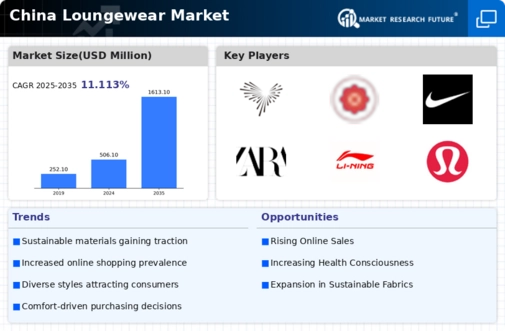Influence of E-commerce Growth
The rapid expansion of e-commerce platforms significantly impacts the loungewear market in China. With the increasing penetration of the internet and mobile devices, online shopping has become a preferred method for consumers. Recent statistics reveal that online sales of loungewear have surged by over 40% in the past year alone. This shift towards digital retailing allows brands to reach a broader audience and cater to diverse consumer preferences. The loungewear market is capitalizing on this trend by enhancing online shopping experiences, offering personalized recommendations, and leveraging social media marketing. As e-commerce continues to grow, it is expected to play a crucial role in shaping the future landscape of the loungewear market, providing both opportunities and challenges for traditional brick-and-mortar retailers.
Growing Demand for Comfort Wear
The loungewear market in China experiences a notable increase in demand for comfort-oriented apparel. As lifestyles evolve, consumers prioritize comfort over traditional formal wear, leading to a shift in purchasing behavior. Recent data indicates that approximately 65% of Chinese consumers prefer loungewear for both home and casual outings. This trend is particularly pronounced among younger demographics, who seek versatile clothing that accommodates both relaxation and social activities. The loungewear market is thus adapting to these preferences by offering a wider range of styles and fabrics that emphasize comfort, such as soft cotton and breathable blends. This growing demand for comfort wear is likely to drive innovation and expansion within the market, as brands strive to meet the evolving expectations of consumers.
Impact of Celebrity Endorsements
Celebrity endorsements play a pivotal role in shaping consumer perceptions within the loungewear market in China. Influencers and celebrities often set trends, and their endorsements can significantly boost brand visibility and desirability. Recent surveys indicate that approximately 45% of consumers are influenced by celebrity endorsements when making purchasing decisions in the apparel sector. The loungewear market is increasingly leveraging this phenomenon by collaborating with popular figures to promote their products. This strategy not only enhances brand credibility but also attracts a wider audience. As the influence of celebrities continues to grow, it is anticipated that their impact on the loungewear market will remain substantial, driving sales and shaping consumer preferences.
Rise of Health and Wellness Trends
The increasing focus on health and wellness among Chinese consumers is influencing the loungewear market. As individuals become more health-conscious, there is a growing preference for clothing that promotes well-being and relaxation. This trend is reflected in the rising popularity of loungewear made from organic and sustainable materials, which align with consumers' values. Approximately 30% of consumers express a willingness to pay a premium for eco-friendly loungewear options. The loungewear market is responding by incorporating health-oriented features, such as moisture-wicking fabrics and ergonomic designs, into their offerings. This alignment with health and wellness trends not only enhances consumer appeal but also positions brands favorably in a competitive market.
Cultural Shift Towards Casualization
A cultural shift towards casualization is reshaping the loungewear market in China. As societal norms evolve, there is a growing acceptance of casual attire in various settings, including workplaces and social gatherings. This shift is particularly evident among millennials and Gen Z consumers, who favor relaxed styles that reflect their lifestyle choices. Data suggests that nearly 50% of young adults in urban areas regularly wear loungewear outside their homes. The loungewear market is adapting to this trend by offering stylish yet comfortable options that cater to this demographic's desire for self-expression. This cultural transformation is likely to sustain the growth of the loungewear market, as brands continue to innovate and align their products with changing consumer attitudes.
























Leave a Comment